Spatial and Temporal Characteristic Analysis of Imbalance Usage in the Hangzhou Public Bicycle System
Abstract
:1. Introduction
2. Background
2.1. Hangzhou Public Bicycle System
2.2. Data
3. Method
3.1. Imbalance Usage Detection
3.2. Area-of-Interest Delineation
- ①
- Status calculation. The NAB of each station is calculated using Equation (1). Usage status is ascertained by the imbalance usage detection method shown as Equation (2). Then, at particular periods, stations in demand conflict are sifted out.
- ②
- Spatial filtering. Stations in the imbalance usage list from Step 2 are further validated by using a spatial filter. For each imbalance station, we find alternate workable stations that are not in conflict within neighbor scope. The neighboring scope is typically determined by the maximal walking distance. If no neighboring docking station is available, which means that all nearby stations are under the imbalance usage, we give the target station real imbalance status and add it to the list of imbalance stations as the input for AOI delineation. If one or more neighbors are available and can assist in the imbalance status, the target station is a fake imbalance station and is removed from the list of imbalance stations.
- ③
- AOI delineation. The final step is to aggregate all real imbalance stations and to generate demand conflict AOI. First, all stations are clustered into different groups, which requires that the distance between any stations that belongs to two different groups must be greater than walking distance, or these points are merged to form a new group. Then, AOIs are generated by concave hull algorithm and forms a minimum area containing a set of clustered stations. The concave hull can well describe the area occupied by the given set of points.
4. Results and Analysis
4.1. Temporal Characteristic of Imbalance Usage
4.1.1. NAB Results between Holidays and Weekdays
4.1.2. Imbalance Usage Detection Results
4.2. Spatial–Temporal Characteristics of Imbalance AOIs
5. Discussion
5.1. Why Station Spacing Matters for PBS in Asian Countries
5.2. Difference before and after Using Spatial Filter
6. Conclusions
Author Contributions
Funding
Conflicts of Interest
References
- Fishman, E.; Washington, S.; Haworth, N. Bike Share’s Impact on Car Use: Evidence from the United States, Great Britain, and Australia. Transp. Res. Part D Transp. Environ. 2014, 31, 13–20. [Google Scholar] [CrossRef] [Green Version]
- Shaheen, S.A.; Martin, E.W.; Cohen, A.P.; Finson, R.S. Public Bikesharing in North America: Early Operator and User Understanding; Mineta Transportation Institute: San Jose, CA, USA, 2012. [Google Scholar]
- Sato, H.; Miwa, T.; Morikawa, T. A Study on Use and Location of Community Cycle Stations. Res. Transp. Econ. 2015, 53, 13–19. [Google Scholar] [CrossRef]
- Wang, Y.; Douglas, M.; Hazen, B. Diffusion of Public Bicycle Systems: Investigating Influences of Users’ Perceived Risk and Switching Intention. Transp. Res. Part A Policy Pract. 2021, 143, 1–13. [Google Scholar] [CrossRef]
- Zhang, F.; Liu, W. An Economic Analysis of Integrating Bike Sharing Service with Metro Systems. Transp. Res. Part D Transp. Environ. 2021, 99, 103008. [Google Scholar] [CrossRef]
- Shaheen, S.A.; Cohen, A.P.; Martin, E.W. Public Bikesharing in North America: Early Operator Understanding and Emerging Trends. Transp. Res. Rec. 2013, 2387, 83–92. [Google Scholar] [CrossRef]
- O’Brien, O.; Cheshire, J.; Batty, M. Mining Bicycle Sharing Data for Generating Insights into Sustainable Transport Systems. J. Transp. Geogr. 2014, 34, 262–273. [Google Scholar] [CrossRef]
- Molina-Garcia, J.; Castillo, I.; Queralt, A.; Sallis, J.F. Bicycling to University: Evaluation of a Bicycle-Sharing Program in Spain. Health Promot. Int. 2015, 30, 350–358. [Google Scholar] [CrossRef] [Green Version]
- Li, A.; Zhao, P.; Huang, Y.; Gao, K.; Axhausen, K.W. An Empirical Analysis of Dockless Bike-Sharing Utilization and Its Explanatory Factors: Case Study from Shanghai, China. J. Transp. Geogr. 2020, 88, 102828. [Google Scholar] [CrossRef]
- Meng, S.; Brown, A. Docked vs. Dockless Equity: Comparing Three Micromobility Service Geographies. J. Transp. Geogr. 2021, 96, 103185. [Google Scholar] [CrossRef]
- Koala Growing Pains. Behind the World’s First Largest Number of Urban Public Bicycles of Chinese Cities. China Bicycl. 2015, 12, 78–81. [Google Scholar]
- Midgley, P. Bicycle-Sharing Schemes: Enhancing Sustainable Mobility in Urban Areas; United Nations, Department of Economic and Social Affairs: New York, NY, USA, 2011; Volume 8, pp. 1–12. [Google Scholar]
- Zhang, Y.; Thomas, T.; Brussel, M.; van Maarseveen, M. Exploring the Impact of Built Environment Factors on the Use of Public Bikes at Bike Stations: Case Study in Zhongshan, China. J. Transp. Geogr. 2017, 58, 59–70. [Google Scholar] [CrossRef]
- Nair, R.; Miller-Hooks, E.; Hampshire, R.C.; Bušić, A. Large-Scale Vehicle Sharing Systems: Analysis of Vélib’. Int. J. Sustain. Transp. 2013, 7, 85–106. [Google Scholar] [CrossRef] [Green Version]
- Zhou, X. Understanding Spatiotemporal Patterns of Biking Behavior by Analyzing Massive Bike Sharing Data in Chicago. PLoS ONE 2015, 10, e0137922. [Google Scholar] [CrossRef] [PubMed]
- Yu, Q.; Gu, Y.; Yang, S.; Zhou, M. Discovering Spatiotemporal Patterns and Urban Facilities Determinants of Cycling Activities in Beijing. J. Geovis. Spat. Anal. 2021, 5, 16. [Google Scholar] [CrossRef]
- Corcoran, J.; Li, T.; Rohde, D.; Charles-Edwards, E.; Mateo-Babiano, D. Spatio-Temporal Patterns of a Public Bicycle Sharing Program: The Effect of Weather and Calendar Events. J. Transp. Geogr. 2014, 41, 292–305. [Google Scholar] [CrossRef]
- Kaltenbrunner, A.; Meza, R.; Grivolla, J.; Codina, J.; Banchs, R. Urban Cycles and Mobility Patterns: Exploring and Predicting Trends in a Bicycle-Based Public Transport System. Pervasive Mob. Comput. 2010, 6, 455–466. [Google Scholar] [CrossRef]
- Chen, L.; Zhang, D.; Wang, L.; Yang, D.; Ma, X.; Li, S.; Wu, Z.; Pan, G.; Nguyen, T.-M.-T.; Jakubowicz, J. Dynamic Cluster-Based over-Demand Prediction in Bike Sharing Systems. In Proceedings of the 2016 ACM International Joint Conference on Pervasive and Ubiquitous Computing, Heidelberg, Germany, 12 September 2016; ACM: New York, NY, USA, 2016; pp. 841–852. [Google Scholar]
- Froehlich, J.E.; Neumann, J.; Oliver, N. Sensing and Predicting the Pulse of the City through Shared Bicycling. In Proceedings of the Twenty-First International Joint Conference on Artificial Intelligence, Pasadena, CA, USA, 14 July 2009. [Google Scholar]
- Wang, J.; Tsai, C.-H.; Lin, P.-C. Applying Spatial-Temporal Analysis and Retail Location Theory to Public Bikes Site Selection in Taipei. Transp. Res. Part A Policy Pract. 2016, 94, 45–61. [Google Scholar] [CrossRef]
- Li, Y.; Zheng, Y.; Zhang, H.; Chen, L. Traffic Prediction in a Bike-Sharing System. In Proceedings of the 23rd SIGSPATIAL International Conference on Advances in Geographic Information Systems, Seattle, WA, USA, 3 November 2015; ACM: New York, NY, USA, 2015; pp. 1–10. [Google Scholar]
- Vogel, P.; Greiser, T.; Mattfeld, D.C. Understanding Bike-Sharing Systems Using Data Mining: Exploring Activity Patterns. Procedia-Soc. Behav. Sci. 2011, 20, 514–523. [Google Scholar] [CrossRef] [Green Version]
- Faghih-Imani, A.; Eluru, N. Incorporating the Impact of Spatio-Temporal Interactions on Bicycle Sharing System Demand: A Case Study of New York CitiBike System. J. Transp. Geogr. 2016, 54, 218–227. [Google Scholar] [CrossRef]
- Ye, X.; Du, J.; Gong, X.; Zhao, Y.; AL-Dohuki, S.; Kamw, F. SparseTrajAnalytics: An Interactive Visual Analytics System for Sparse Trajectory Data. J. Geovis. Spat. Anal. 2021, 5, 3. [Google Scholar] [CrossRef]
- Liu, F.; Andrienko, G.; Andrienko, N.; Chen, S.; Janssens, D.; Wets, G.; Theodoridis, Y. Citywide Traffic Analysis Based on the Combination of Visual and Analytic Approaches. J. Geovis. Spat. Anal. 2020, 4, 15. [Google Scholar] [CrossRef]
- Maleki Vishkaei, B.; Mahdavi, I.; Mahdavi-Amiri, N.; Khorram, E. Balancing Public Bicycle Sharing System Using Inventory Critical Levels in Queuing Network. Comput. Ind. Eng. 2020, 141, 106277. [Google Scholar] [CrossRef]
- Patel, S.J.; Patel, C.R. A Stakeholders Perspective on Improving Barriers in Implementation of Public Bicycle Sharing System (PBSS). Transp. Res. Part A Policy Pract. 2020, 138, 353–366. [Google Scholar] [CrossRef]
- Borgnat, P.; Abry, P.; Flandrin, P.; Robardet, C.; Rouquier, J.-B.; Fleury, E. Shared bicycles in a city: A signal processing and data analysis perspective. Adv. Complex Syst. 2011, 14, 415–438. [Google Scholar] [CrossRef] [Green Version]
- Fricker, C.; Gast, N. Incentives and Redistribution in Homogeneous Bike-Sharing Systems with Stations of Finite Capacity. EURO J. Transp. Logist. 2016, 5, 261–291. [Google Scholar] [CrossRef] [Green Version]
- O’Mahony, E.; Shmoys, D. Data Analysis and Optimization for (Citi)Bike Sharing. In Proceedings of the AAAI Conference on Artificial Intelligence, Austin, TX, USA, 25–30 February 2015; Volume 29. [Google Scholar]
- Ciancia, V.; Latella, D.; Massink, M.; Pakauskas, R. Exploring Spatio-Temporal Properties of Bike-Sharing Systems. In Proceedings of the 2015 IEEE International Conference on Self-Adaptive and Self-Organizing Systems Workshops, Cambridge, MA, USA, 21 September 2015; IEEE: Piscataway, NJ, USA, 2015; pp. 74–79. [Google Scholar]
- Qian, J.; Zheng, Z.; Feng, Y. An Assessment of the Public Bicycle Facilities in Hangzhou. Planners 2010, 26, 71–76. [Google Scholar]
- Shaheen, S.A.; Guzman, S.; Zhang, H. Bikesharing in Europe, the Americas, and Asia: Past, Present, and Future. Transp. Res. Rec. 2010, 2143, 159–167. [Google Scholar] [CrossRef] [Green Version]
- Yao, Y.; Zhou, Y. Bike Sharing Planning System in Hangzhou. Urban Transp. China 2009, 7, 30–38. [Google Scholar]
- Wang, S.; Zhang, J.; Liu, L.; Duan, Z. Bike-Sharing-A New Public Transportation Mode: State of the Practice & Prospects. In Proceedings of the 2010 IEEE International Conference on Emergency Management and Management Sciences, Beijing, China, 8–10 August 2010; IEEE: Piscataway, NJ, USA, 2010; pp. 222–225. [Google Scholar]
- Hangzhou Public Bicycle Transportation Service Development Co., Ltd. Bicycle Service. Available online: http://www.ggzxc.cn/ (accessed on 1 February 2019).
- Li, J.; Wang, F. Characteristics of Bike Sharing Service in Hangzhou Based on Open Data. Urban Transp. China 2017, 15, 63–73. [Google Scholar]
- Shi, X.; Yu, Z.; Chen, J.; Xu, H.; Lin, F. The Visual Analysis of Flow Pattern for Public Bicycle System. J. Vis. Lang. Comput. 2018, 45, 51–60. [Google Scholar] [CrossRef]
- Ministry of Housing and Urban-Rural Development. Guidelines for Planning and Design of Urban Pedestrian and Bicycle Transport System. 2013. Available online: http://www.mohurd.gov.cn/wjfb/201401/t20140114_216859.html (accessed on 16 September 2021).

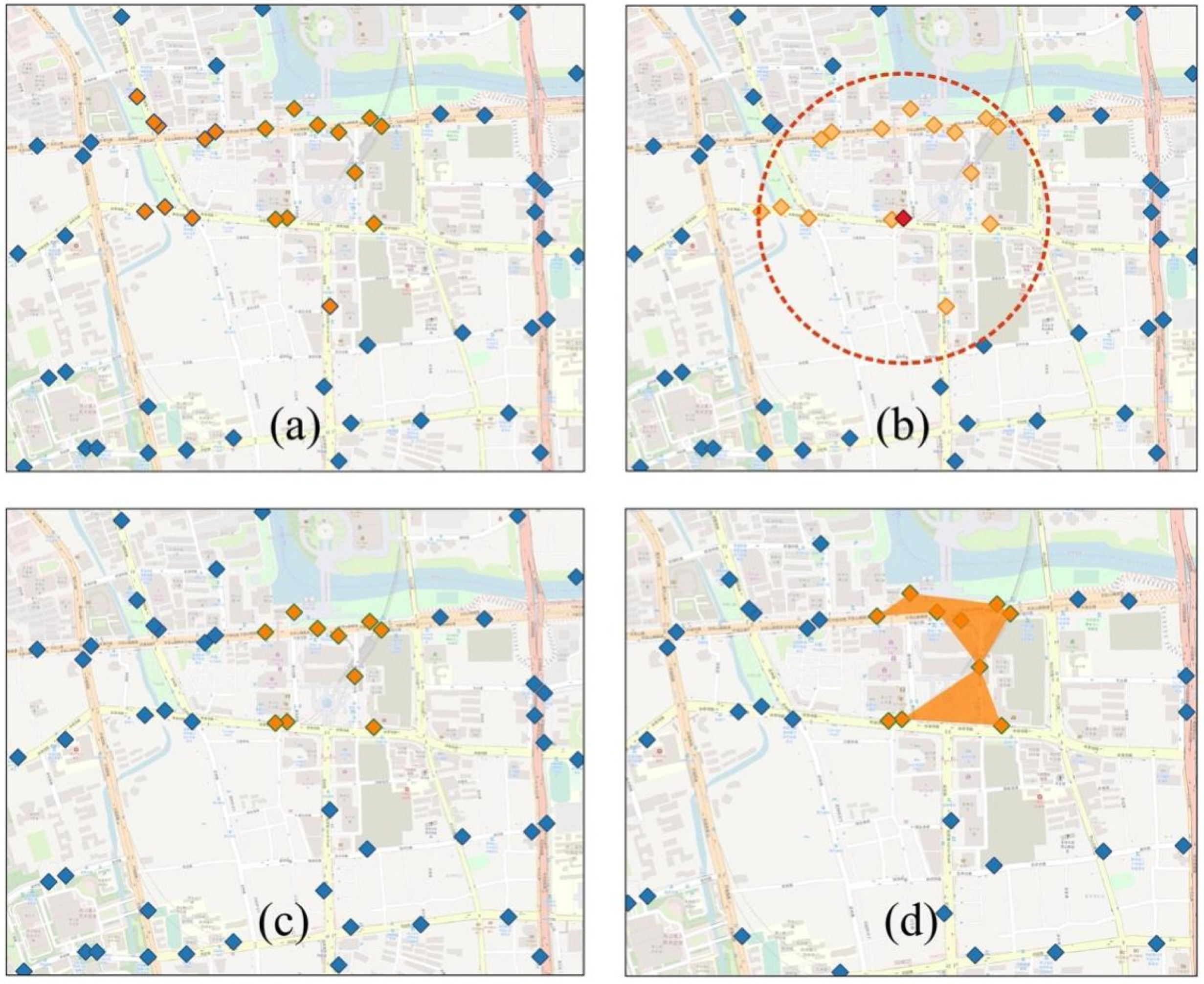

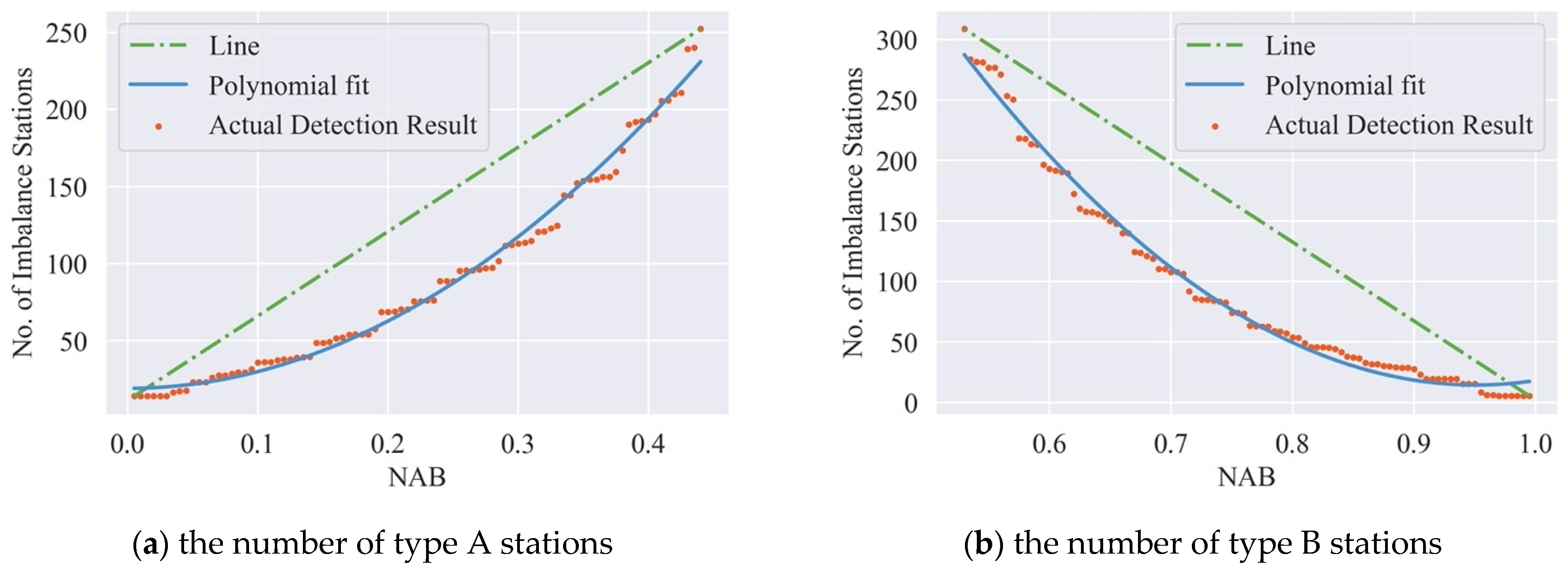

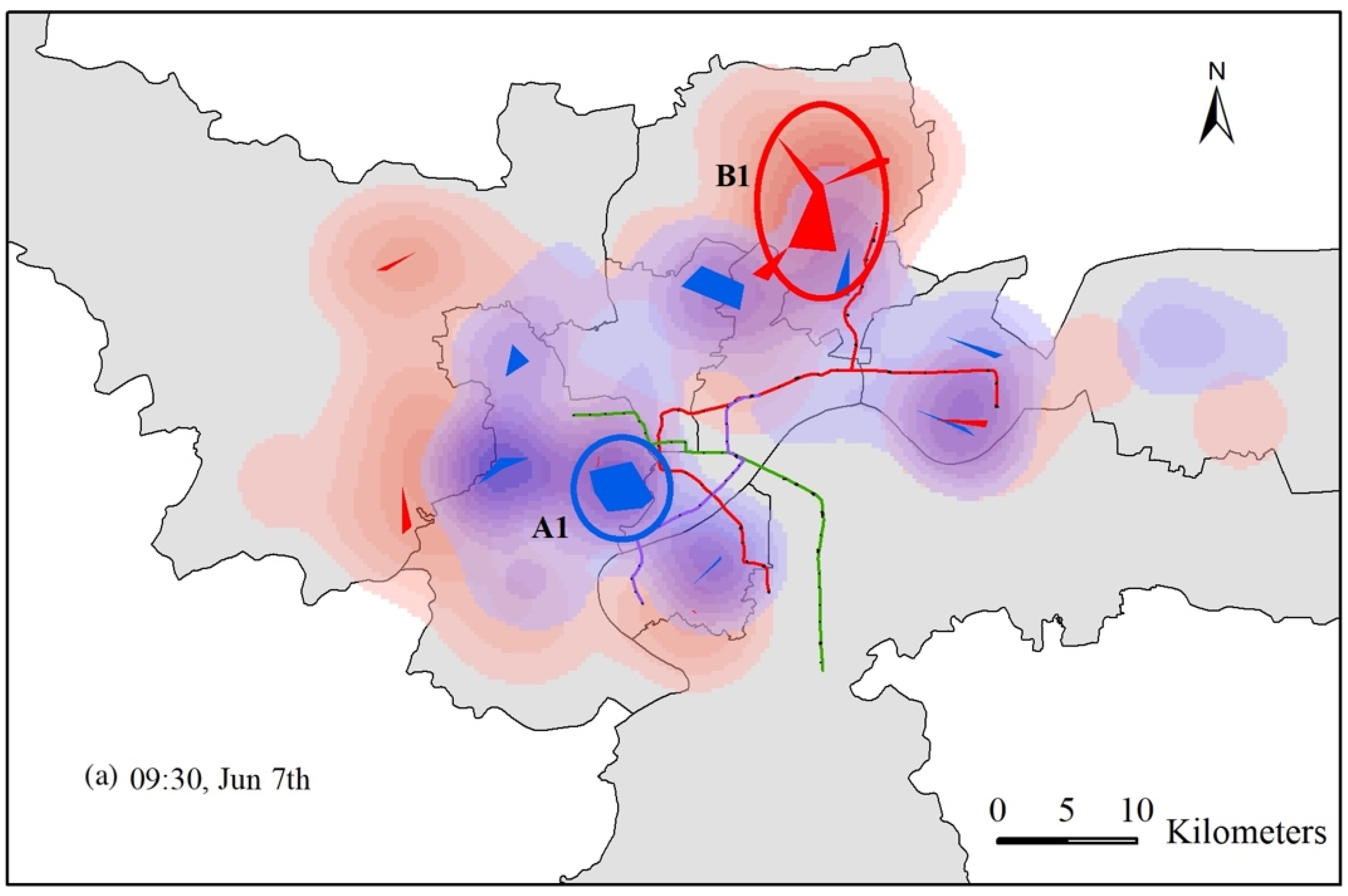

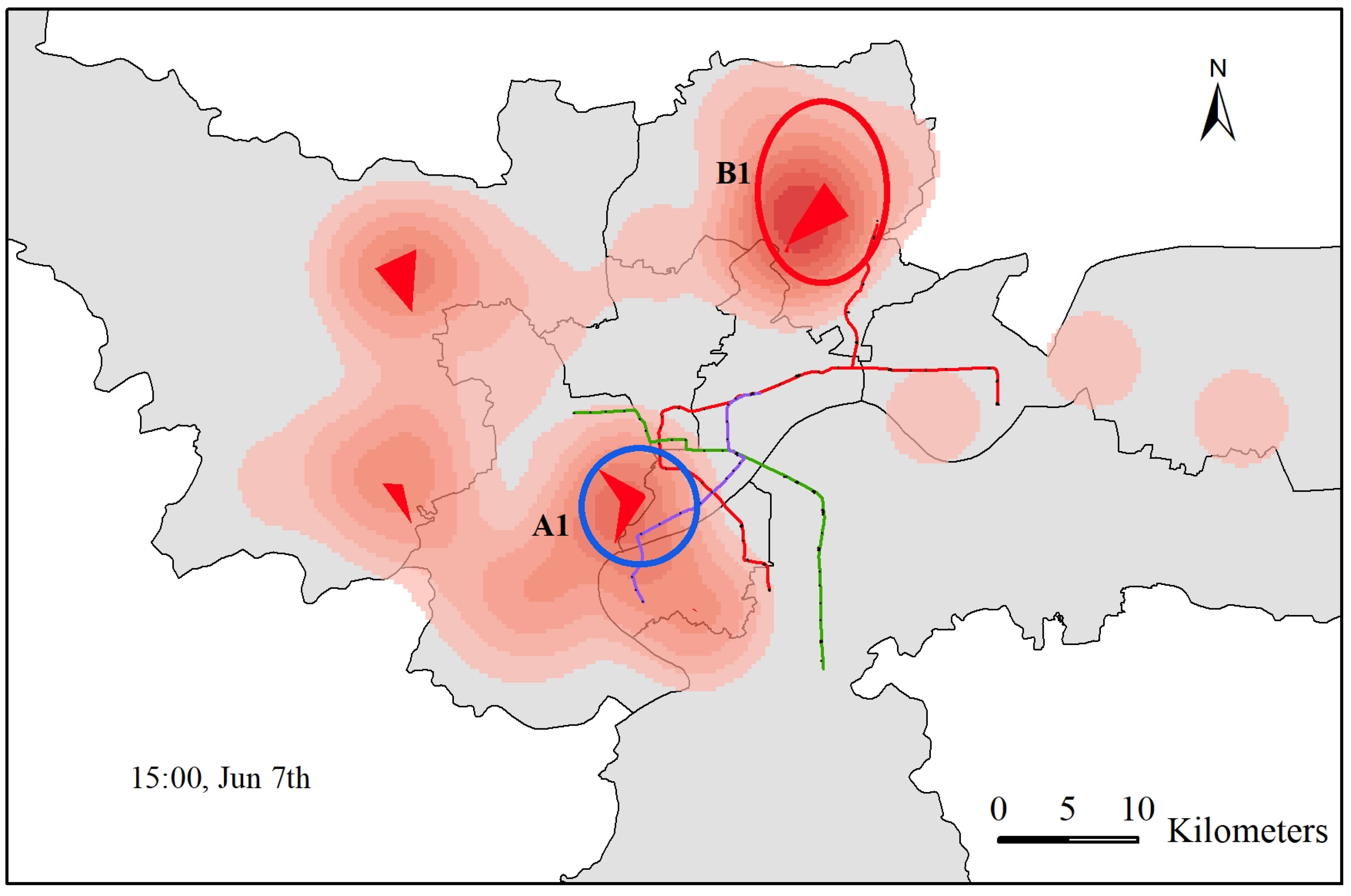
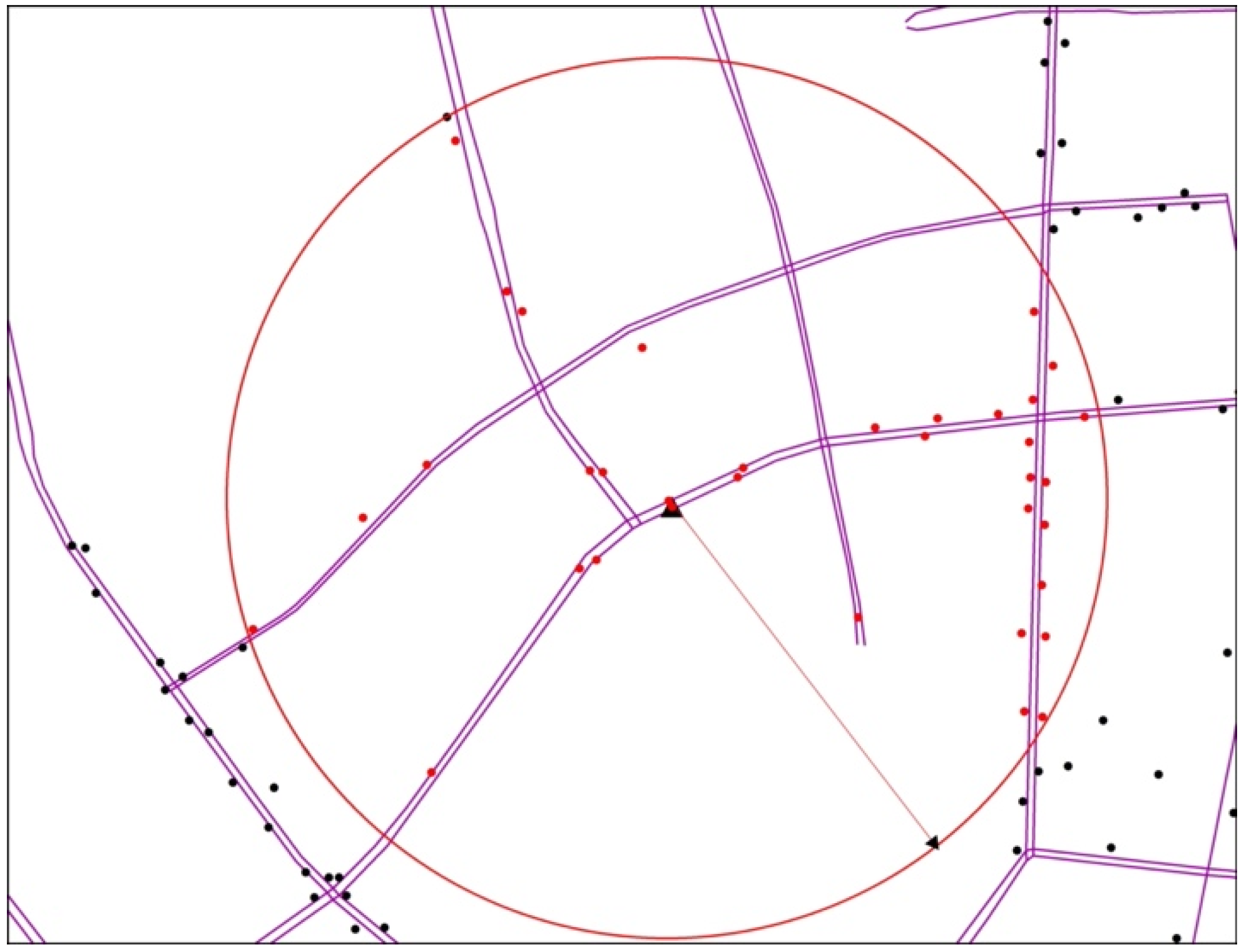
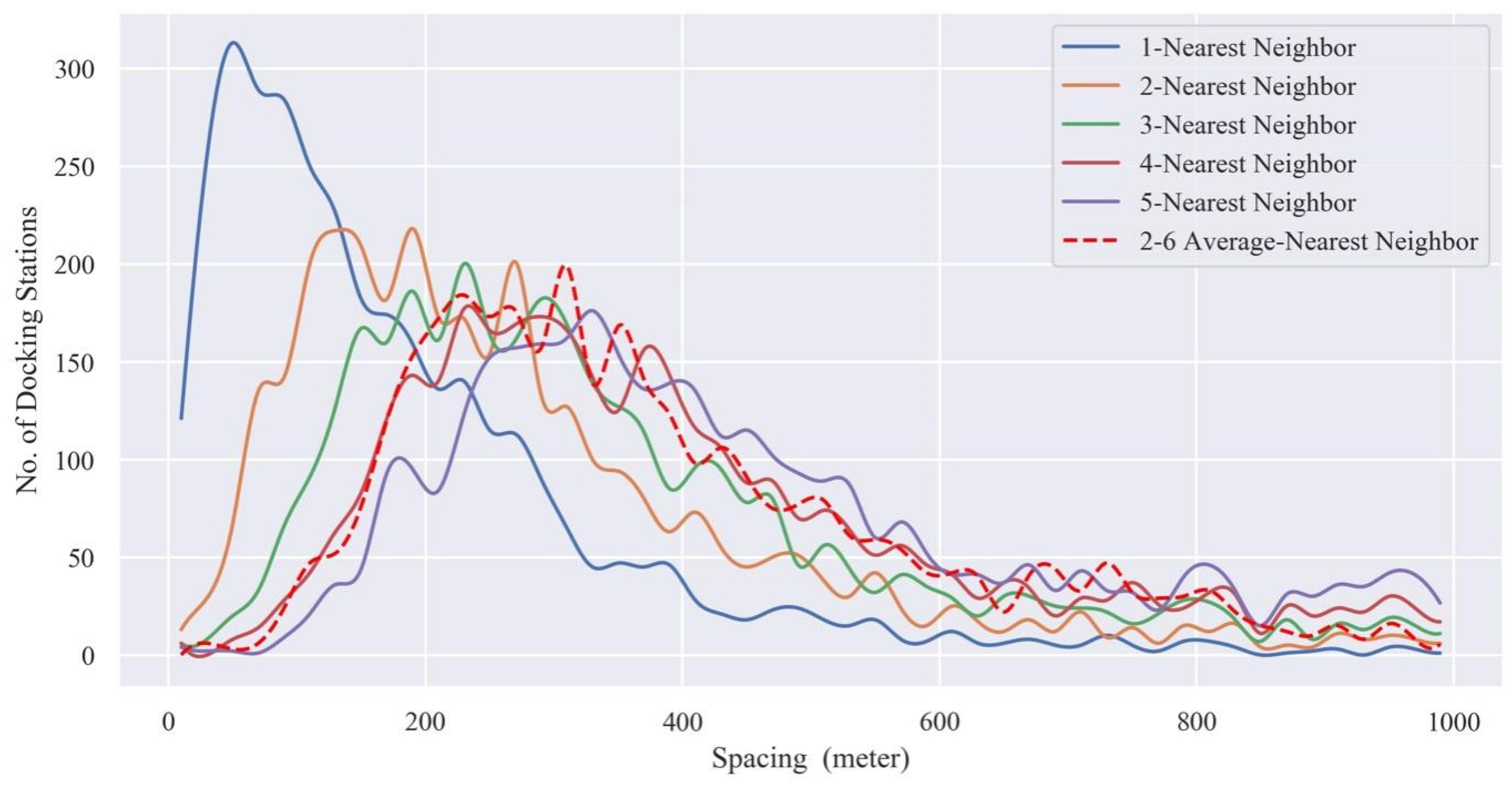
| Time | Conflict Type | Before Spatial Filtering | After Spatial Filtering | Ratio |
|---|---|---|---|---|
| 10:00 a.m. 7 June 2019 | A | 934 | 46 | 4.93% |
| 15:00 p.m. 7 June 2019 | B | 626 | 38 | 6.07% |
| 10:00 a.m. 8 June 2019 | A | 881 | 35 | 3.97% |
| 15:00 p.m. 8 June 2019 | B | 590 | 36 | 6.10% |
| 10:00 a.m. 9 June 2019 | A | 894 | 46 | 5.15% |
| 15:00 p.m. 9 June 2019 | B | 593 | 46 | 7.76% |
| 08:50 a.m. 10 June 2019 | A | 1121 | 90 | 8.03% |
| 09:30 a.m. 10 June 2019 | B | 664 | 61 | 9.19% |
| 08:50 a.m. 11 June 2019 | A | 1096 | 90 | 8.21% |
| 09:30 a.m. 11 June 2019 | B | 648 | 53 | 8.18% |
| 08:50 a.m. 12 June 2019 | A | 1092 | 76 | 6.96% |
| 09:30 a.m. 12 June 2019 | B | 633 | 53 | 8.37% |
| 08:50 a.m. 13 June 2019 | A | 1076 | 99 | 9.20% |
| 09:30 a.m. 13 June 2019 | B | 639 | 53 | 8.29% |
| 08:50 a.m. 14 June 2019 | A | 1139 | 82 | 7.20% |
| 09:30 a.m. 14 June 2019 | B | 631 | 47 | 7.45% |
Publisher’s Note: MDPI stays neutral with regard to jurisdictional claims in published maps and institutional affiliations. |
© 2021 by the authors. Licensee MDPI, Basel, Switzerland. This article is an open access article distributed under the terms and conditions of the Creative Commons Attribution (CC BY) license (https://creativecommons.org/licenses/by/4.0/).
Share and Cite
Zhang, X.; Chen, Y.; Zhong, Y. Spatial and Temporal Characteristic Analysis of Imbalance Usage in the Hangzhou Public Bicycle System. ISPRS Int. J. Geo-Inf. 2021, 10, 637. https://doi.org/10.3390/ijgi10100637
Zhang X, Chen Y, Zhong Y. Spatial and Temporal Characteristic Analysis of Imbalance Usage in the Hangzhou Public Bicycle System. ISPRS International Journal of Geo-Information. 2021; 10(10):637. https://doi.org/10.3390/ijgi10100637
Chicago/Turabian StyleZhang, Xiaoyi, Yurong Chen, and Yang Zhong. 2021. "Spatial and Temporal Characteristic Analysis of Imbalance Usage in the Hangzhou Public Bicycle System" ISPRS International Journal of Geo-Information 10, no. 10: 637. https://doi.org/10.3390/ijgi10100637






